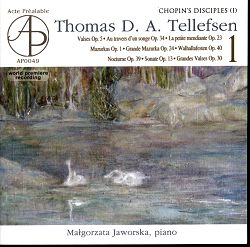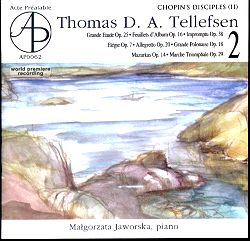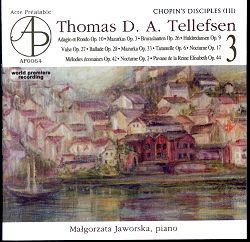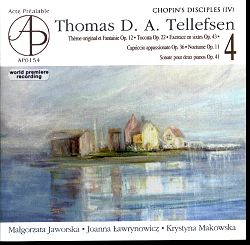 |
Thomas
D. A. TELLEFSEN (1823-1874)
Complete Piano Works Volume 1
Quatre Mazurkas op. 1 (1846) [11:39]
Grande Mazurka op. 24 in B flat
major (1857) [5:48]
Walhallafesten op. 40 (c.1873)
[5:30]
Nocturne op. 39 in G flat major
(1872) [5:09]
Sonate op. 13 in C minor (1848)
[18:58]
Trois Valses op. 5 (1851) [7:41]
Grande Valse op. 30 no. 1 in F
major (c.1860-62) [4:35]
Grande Valse op. 30 no. 2 in F
minor (c.1860-62) [4:54]
Au travers d'un songe op. 34 [3:59]
La petite mendiante op. 23 (c.1857)
[2:11]
Malgorzata Jaworska (piano)
rec. Warsaw Studio S2, December
1999
ACTE PRÉALABLE AP0049
[70:32]
Musicweb
Purchase button
|
 |
Complete Piano Works Volume
2
Grande Etude op. 25 [4:18]
Feuillets d'Album op. 16 [12:52]
Impromptu op. 38 in G major [3:53]
Elégie op. 7 (1852) [8:11]
Allegretto in A major op.20 [3:03]
Grande Polonaise op. 18 in C sharp
major (1855) [9:12]
Mazurkas op. 14 (1853-54) [18:33]
Marche Triomphale op. 29 in E
flat major (1860) [8:13]
Malgorzata Jaworska (piano)
rec. Warsaw Studio S2, July 2000
ACTE PRÉALABLE AP0062
[68:22]
Musicweb
Purchase button
|
 |
Complete Piano Works Volume
3
Valse in D flat major op. 27 (1850s)
[3:39]
Ballade op. 28 (1860) [4:08]
Mazurka in A major op. 33 (1860s)
[5:52]
Tarantelle op. 6 (1851) [4:07]
Nocturne in G minor op. 17 (c.1850s
pub. 1885) [4:40]
Adagio et Rondo op. 10 (1850)
[9:37]
Quatre Mazurkas op. 3 (1849) [9:56]
Bruraslaatten op. 26 (1850s) [3:55]
Huldredansen op. 9 (1850s) [3:01]
Mélodies écossaises
op. 42 [7:41]
Nocturne in F major op. 2 (1849)
[4:12]
Pavane de la Reine Elisabeth op.
44 (pub.1881) [6:25]
Malgorzata Jaworska (piano)
rec. Warsaw Studio S2, July 2000
and June 2001
ACTE PRÉALABLE AP0064
[67:19]
Musicweb
Purchase button
|
 |
Complete Piano Works Volume
4
Thème original et Fantaisie
Op. 12 [10:58]
Toccata Op. 22 [9:34]
Exercice en sixtes Op. 43 [2:56]
Capriccio appassionato Op. 36
(1868) [6:08]
Nocturne in E major Op. 11 (1853)
[3:05]
Sonate pour deux pianos Op. 41
(1870) [25:23] *
Malgorzata Jaworska (piano)
Joanna Lawrynowicz and Krystyna
Makowska (pianos)*
rec. Warsaw Studio S1, July 2006
and February 2007
ACTE PRÉALABLE AP0154
[58:08]
Musicweb
Purchase button
|
Thomas Tellefsen
is succinctly summed up in the booklet
notes as "Norwegian composer and
Chopin’s pupil." He was born in
1823 in Trondheim and studied the piano,
moving to Paris in 1842. It was George
Sand who arranged Tellefsen’s first
meeting with Chopin in November 1844
and the Norwegian studied piano and
composition with him until 1847. In
1848, after the Revolution, they both
travelled to London. Tellefsen was clearly
trusted by Chopin; the planned Chopin
piano school (never realised) was to
have been organised by Tellefsen. But
after Chopin’s death Tellefsen did take
on a number of Chopin’s students and
his reputation as a pedagogue increased.
After another spell in London, from
1870-73, to escape the Franco-German
war, he returned to the city where he
had spent almost his entire adult life
and it was here that he died in 1874.
Tellefsen was clearly
a leading Parisian virtuoso. He frequently
performed Chopin’s works as well as
his own solo and concertante works.
He disseminated baroque literature,
teamed up with eminent chamber music
contemporaries, Gounod among them, and
worked unstintingly as an editor. He
wrote forty-four works and broadly sought
to fuse Norwegian folk influences with
Chopinesque models such as mazurkas
and ballades. He is now no more than
a footnote in Chopin studies so this
welcome collection of four discs – realised
under the rubric Chopin’s Disciples
is a valuable opportunity to acquaint
oneself with the music of an executant-composer
now almost completely forgotten.
The four volumes were
recorded in sequence between 1999 and
2007. The first volume includes the
Op.1 Mazurkas, simple and effective
Norwegian-hued pieces. The third has
a certain tristesse whilst the final
one is the most Chopin influenced and
sporting rather too much decorative
business. The works aren’t presented
chronologically so the late c.1873 Walhallafesten
sits in the first volume alongside these
early examples. It’s obviously a much
more sophisticated affair and the name
suggests the Norwegian influence – a
fine dance tune, limpidly spun, and
with fine right hand tracery. The 1848
Sonata is by contrast a very
old-fashioned salon affair with a central
movement that maybe hints at Schumann.
One of the highlights of this first
volume is Au travers d'un songe,
a brief but rather lovely and flowing
cantabile with broken chords in semi
quavers – interesting to reflect on
its possible influence on Chopin. It’s
the best piece here – a worthy entrant
to the concert repertoire.
The second volume sports
a flowing Grande Etude and a
decidedly Chopinesque Feuillets d'Album
– especially the funeral march [No.3]
which pays strong homage to the similar
movement in Chopin’s sonata. The Elégie
is another sombre work ending in
a chorale but good programming ensures
that this downbeat sequence is ended
by a light-hearted Allegretto.
The Grande Polonaise is by contrast
powerful, dramatic and processional
– a fine vehicle for salon and recital
hall virtuosity – and one that has a
particularly fine dolce section.
The op.14 Mazurkas are an attractive
set, indebted to Norwegian folk models
as much as Chopin, though perhaps a
touch cosmopolitan in style. The second
disc ends with the maestoso grandeur
of the Marche Triomphale.
The op.28 Ballade,
which opens volume three, is strongly
hewn and has a concentrated power that
impresses powerfully. Certainly its
indebtedness to Chopin is clear but
what’s equally evident is the strength
of Tellefsen’s own imaginative resources
and creative independence. This having
been noted one problem with a complete
survey such as this is the up-and-down
nature of the inspiration. After this
fine work we have some appealing but
essentially decorative pieces of no
great intrinsic merit. Still, the Huldredansen
is an attractive Norwegian halling
and the fourth of the Op.3 set of
Mazurkas sounds strongly like
a Polish kuyawiak.
The fourth and final
volume similalrly ranges over Tellefsen’s
oeuvre though it focuses a little more
closely on the later works. The relatively
early Thème original et Fantaisie
is notable for an influence otherwise
largely missing from his compositions
– Liszt, whose shade adds portentous
gravity to the opening before the more
expected Chopin-styled decoration takes
over. The Op.22 Toccata is technically
taxing though hardly in Schumann’s league
compositionally. The Exercice en
sixtes is what it sounds like –
pedagogic in origin. Capriccio appassionato
is rather flashy, and the Nocturne
Op.11 owes a dual Field-Chopin inheritance.
Finally there’s a big Sonata for two
pianos, the only work here not played
by the indefatigable Malgorzata Jaworska;
Joanna Lawrynowicz and Krystyna Makowska
do the honours for this work. Written
in 1870 this is an exciting if, by then,
rather old hat opus. Over-extended it
most certainly is but the players relish
the enjoyable tunes and the clamorous
drive of the thing.
This series of four
discs is excellently annotated and has
some rather beautiful art work into
the bargain. Texts are in Polish, English,
French and Norwegian. Malgorzata Jaworska
is the dedicated and accomplished star
of the series and she’s been generally
well recorded; there’s too much air
around the action of her piano in volume
three but the ear adjusts. A highlights
disc might be appropriate in order to
focus the ear on Tellefsen’s best works
but the Completist will have his fill
with this set - all available singly
by the way.
Jonathan Woolf

